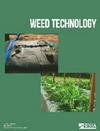Smooth scouringrush (Equisetum laevigatum) control with glyphosate is affected by surfactant choice and application time
IF 1.7
3区 农林科学
Q3 AGRONOMY
引用次数: 0
Abstract
Smooth scouringrush is a creeping perennial with a high silica content in stems that may impede herbicide uptake. Smooth scouringrush has become a troublesome weed in no-till cropping systems across eastern Washington. In previous field studies, glyphosate provided inconsistent control of smooth scouringrush. The objective of this study was to determine if the addition of an organosilicone surfactant to glyphosate would improve the efficacy and consistency of control through stomatal flooding. To test this hypothesis, glyphosate was applied at three field sites at 3.78 kg ae ha-1 alone, with an organosilicone surfactants (OS1 and OS2), an organosilicone plus nonionic surfactant blend, or an alcohol-based surfactant applied during the day or at night. Stem counts were taken one year after herbicide applications. Five of the six effective treatments observed across the three study sites included organosilicone surfactant or an organosilicone plus nonionic surfactant blend. At two sites, when there was a difference in efficacy between application times, daytime applications were more effective than nighttime applications. These results support the hypothesis of stomatal flooding as a likely mechanism for enhanced efficacy of glyphosate with the addition of an organosilicone surfactant. However, at one site, the treatments containing organosilicone surfactant were more efficacious when applied at night than during the day. At this site, high daytime temperatures and low relative humidity may have resulted in rapid evaporation of spray droplets. The addition of an organosilicone surfactant to glyphosate is recommended for smooth scouringrush control and daytime treatments are preferred but should be applied when temperatures and humidity are not conducive to rapid droplet drying. Further research is necessary to confirm that stomatal flooding is responsible for improved glyphosate efficacy.表面活性剂的选择和施用时间会影响草甘膦对金刚草的平滑冲刷控制
顺草是一种匍匐多年生植物,茎中硅含量高,可能会阻碍除草剂的吸收。在华盛顿东部的免耕种植系统中,草鞭草已经成为一种麻烦的杂草。在以前的实地研究中,草甘膦对光滑的鞭毛病的控制效果不一致。本研究的目的是确定在草甘膦中加入有机硅表面活性剂是否会提高通过气孔淹水控制的有效性和一致性。为了验证这一假设,草甘膦在三个现场以3.78 kg ae - ha-1单独施用,与有机硅表面活性剂(OS1和OS2),有机硅加非离子表面活性剂混合物,或醇基表面活性剂在白天或晚上施用。使用除草剂一年后进行茎干计数。在三个研究地点观察到的六种有效处理方法中,有五种包括有机硅表面活性剂或有机硅加非离子表面活性剂的混合物。在两个地点,当使用时间不同时,白天使用比夜间使用更有效。这些结果支持了气孔泛洪可能是添加有机硅表面活性剂增强草甘膦功效的机制的假设。然而,在一个部位,含有有机硅表面活性剂的处理在夜间比在白天更有效。在这个地点,白天的高温和较低的相对湿度可能导致喷雾液滴迅速蒸发。建议在草甘膦中添加有机硅表面活性剂,以平滑控制刷毛,首选白天处理,但应在温度和湿度不利于快速干燥的情况下应用。需要进一步的研究来证实气孔淹水是提高草甘膦功效的原因。
本文章由计算机程序翻译,如有差异,请以英文原文为准。
求助全文
约1分钟内获得全文
求助全文
来源期刊

Weed Technology
农林科学-农艺学
CiteScore
2.90
自引率
21.40%
发文量
89
审稿时长
12-24 weeks
期刊介绍:
Weed Technology publishes original research and scholarship in the form of peer-reviewed articles focused on understanding how weeds are managed.
The journal focuses on:
- Applied aspects concerning the management of weeds in agricultural systems
- Herbicides used to manage undesired vegetation, weed biology and control
- Weed/crop management systems
- Reports of new weed problems
-New technologies for weed management and special articles emphasizing technology transfer to improve weed control
-Articles dealing with plant growth regulators and management of undesired plant growth may also be accepted, provided there is clear relevance to weed science technology, e.g., turfgrass or woody plant management along rights-of-way, vegetation management in forest, aquatic, or other non-crop situations.
-Surveys, education, and extension topics related to weeds will also be considered
 求助内容:
求助内容: 应助结果提醒方式:
应助结果提醒方式:


